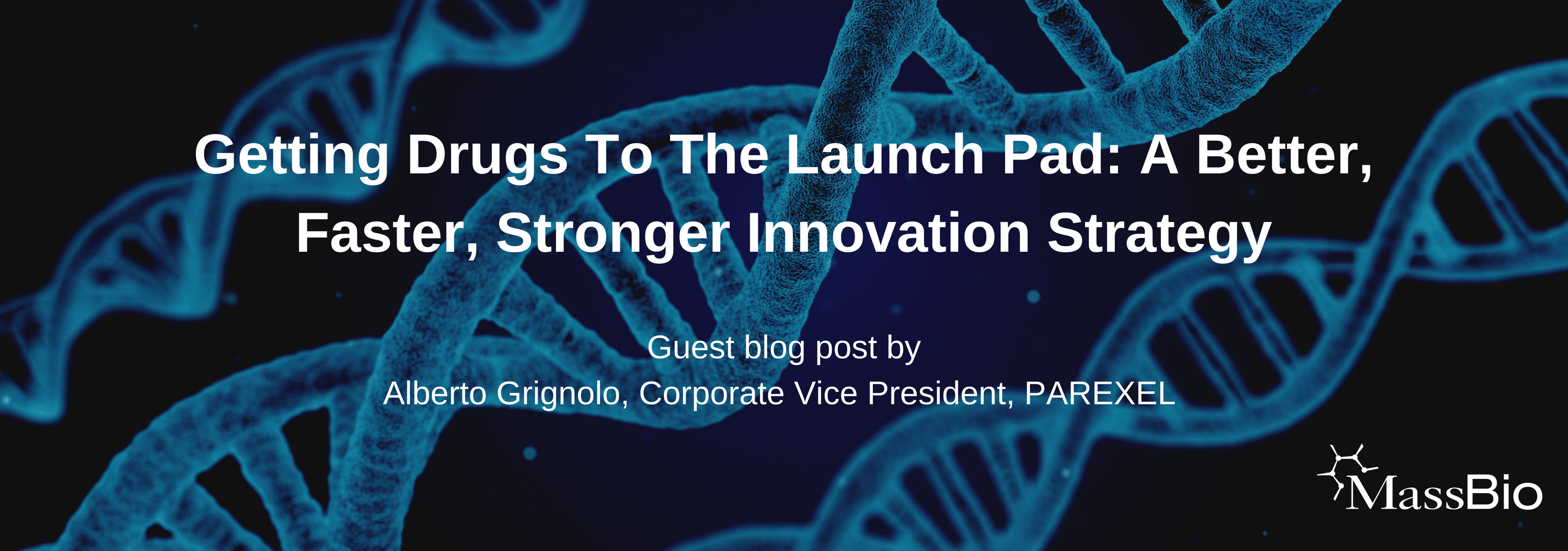
Drugs fail to make it to launch 90 percent of the time; what if we could improve the likelihood of market launch by 10 percent? 20 percent?
In a field where drug development costs $2.6 billion, and time to market launch takes 12 years, a 10-20 percent increase could save millions of dollars, while enabling the industry to better meet patient needs more quickly. So, how do we do this? Surprisingly, via more widespread adoption of innovative clinical trial design.
The Innovation Imperative
Research recently conducted by the Economist Intelligence Unit (EIU) and commissioned by PAREXEL assessed how innovation drives efficiency and improves likelihood of launch of new  therapies, ultimately benefiting patients. The resulting report, The Innovation Imperative: The Future of Drug Development, suggests that if innovative clinical trial designs – including adaptive, patient-centric, precision medicine, and real-world data (RWD) designs – were more widely adopted, then biopharmaceutical development could become more sustainable. In fact, drugs developed using these innovations were 10-21 percent more likely to make it to launch than those that did not. The research also showed that drugs developed with these innovations in three therapeutic areas, including neurology, oncology and rare diseases, were 16 percent more likely to be launched than drugs that did not use these innovations.
therapies, ultimately benefiting patients. The resulting report, The Innovation Imperative: The Future of Drug Development, suggests that if innovative clinical trial designs – including adaptive, patient-centric, precision medicine, and real-world data (RWD) designs – were more widely adopted, then biopharmaceutical development could become more sustainable. In fact, drugs developed using these innovations were 10-21 percent more likely to make it to launch than those that did not. The research also showed that drugs developed with these innovations in three therapeutic areas, including neurology, oncology and rare diseases, were 16 percent more likely to be launched than drugs that did not use these innovations.
Key Findings: Innovative Trial Design Drives Efficacy and Efficiency
Other key findings from this analysis include:
- Of the four types of trial innovation, RWD trials had the highest increase in the likelihood of market launch (21 percent).
- Of the three therapeutic areas, oncology trials benefited the most from these innovations, with the likelihood of market launch increasing 33 percent (from 53 percent to 86 percent) compared to trials not using these trial types.
- Patient-centric and RWD trials experienced the shortest recruitment times (4-6 months versus an average of 7 months).
- Rare disease trials reduced their recruitment time the most (40 percent, from 30 to 18 months).
- Drugs developed using these innovations were 41 percent more likely to achieve formulary or market authorization than those that didn’t use them.
With these results, utilization of clinical trial innovations would seem obvious. Yet adaptive and RWD trials were adopted less than 1 percent of the time, patient-centric trials 5 percent, and precision medicine trials 14 percent.
Why are such effective strategies not more widely adopted? The EIU report identifies four main barriers to industry-wide utilization:
- vast, new and fragmented data;
- a small or not adequately trained workforce;
- negative perceptions of the biopharmaceutical industry; and
- cultural barriers, including risk aversion and siloed of information.
The EIU Report call for our industry to work together—with competitors, payers, patients and regulators—to collectively break down these barriers. Four key factors identified in EIU’s research can drive progress on this:
- Advanced data analytics – We are experiencing a deluge of health data. Integrating data capture and analytics across the continuum will require stakeholders to develop and implement commonly-agreed upon strategies and standards for data sharing and interoperability, data prioritization and integration of alternative data sources and predictive analytics. This will help ensure priority data is identified, patient registry information is leveraged, diverse patient data is integrated, and trials at risk for early termination can be prevented from even commencing.
- Workforce readiness – We need a workforce that is informed and passionate about data science and clinical trials. Our workforce must be able to appropriately and adequately collect, manage, assure the quality of, and analyze unconventional data. We also need individuals trained in clinical trial coordination to drive consistency among trials, leading to better, more reliable outputs.
- Collaborative partnerships – Trust, in the form of multilateral partnerships, has long been integral to the success of the biopharmaceutical business model. Well-defined partnerships and ‘coopetition’ will allow stakeholders to work together and learn from each other without permanently altering the competitive landscape.
- Early stakeholder involvement – The speed and success of biopharmaceutical research is incumbent upon stakeholders agreeing on a shared set of development objectives. Patients, in particular, can provide much-needed insights into their disease, treatment methodology, therapy effectiveness, and patient engagement in clinical trials.
Conclusion
This report is a call to action for all stakeholders in the drug development space. The biopharmaceutical industry excels at creating innovative therapies. Let us also excel at creating an innovative drug development infrastructure that drives efficiency, improves success and benefits patients.
We must work urgently to connect the silos that have traditionally divided competitors, payers, patients and regulators, and have inhibited progress. It is easy to continue doing research the way we always have. Now is the time to look at the big picture. Patients are waiting.